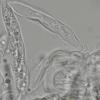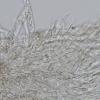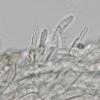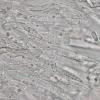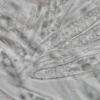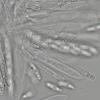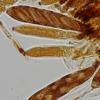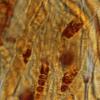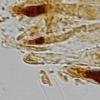
21-12-2025 09:32
Hello.A tiny ascomycete found embedded in wood in

21-12-2025 21:32
Pol DebaenstHello, Garden, Burgweg 19, Veurne, BelgiumOn 10/1

22-12-2025 23:38
Patrice TANCHAUDBonsoir, récolte sur un mur en pierre, apothéci

22-12-2025 00:47
Patrice TANCHAUDBonsoir, récolte à proximité du milieu dunaire

21-12-2025 21:40
Isabelle CharissouBonjour, j'aimerais connaitre les références de

20-12-2025 23:08
Patrice TANCHAUDBonsoir, récolte sur sol sablonneux dans l'arri�
 Hello,
Hello,We found a nice Carex acuta growth recently and have since tried to get a hold of the Hyaloscyphaceaes on them. Some of the species key out nicely (Cistella lagenipila, Albotricha acutipila for example), but some don't.
Let's start with this one:
A prominently hairy white disco on C.acuta leaf. Stipitate, stipe dark at the bottom, some of the lower excipular cells with brownish pigment. Excipulum thin to thick walled.
Paraphyses lanceolate with many VBs. Some fine warts/granules on the upper part of the paraphyse. Granules ammonia resistant.
Hairs finely granulated for the whole length of the top-most cell atleast. Thin-walled. On flanks hairs +- cylindrical. Non-smooth paraphyses confuse me while studying hairs in the margin. Maybe all hairs are like the ones on flanks. Not sure.
Asci arise from croziers. Spores 14-16 x 4-4,5 um. Often with two large guttulae.
Mounts in water. Mind all the missing details, specimen still alive and kicking.
Has to be a Cistella, right, but where are we there?
Timo

I see only a few VB-drops in the tips of paraphyses, not further below. This first reminded me of "Helotium" microspis (I have it in the Calycellina folder), but otherwise it is much too different. The warted paraphysis tips and dark apo base points to a Ciliolarina, though I am unaware of one on monocots, and VBs are elongate, not globose there. What you should do is a test with Cresyl Blue: the spore wall selectively stains deep lilac in Ciliolarina.
Also please measure the asci (only living and mature!). Did you check the Lugol reaction?
Zotto

Asci 70-90 X 9-12 um. hemiamyloid ring.
No Cresyl blue here right now. VBs mainly/only in the apical cell of the paraphyses. Spores in water often with a very large VB that resembles a rectangle with rounded corners.
How about a Fuscolachnum – or something towards "Lachnum" anyway?

But I am unable to say a genus. Lachnum does not have such hairs and paraphyses. Fuscolachnum is a good idea, maybe hyaline members exist.
VBs I cannot see in the livin spores, I see only 2-3 large LBs and some smaller ones.

Apart from Carex, we have some Iris angustifolia material. Nice Hyalopezizas AND something that looks like Iridinea! Weak amyloid reaction in the hairs, ecology and hairs match, maybe slightly immature, but we will try to culture it. How common is it? Do you have lot's of collections?
Timo
-Hello from Seppo (who now finally has time for serious microscopy) and from Karen too!

Iridinea: you find the genus in my folder 7i Calloriaceae (Naevioideae)
I think that raripila isn't so rare, also diaphana is perhaps not so rare, I see about 10 collections of each of them in my database.
hamulata is perhaps only in the higher montains (subalpine).

